非谓语动词专题复习
- 格式:ppt
- 大小:4.55 MB
- 文档页数:26
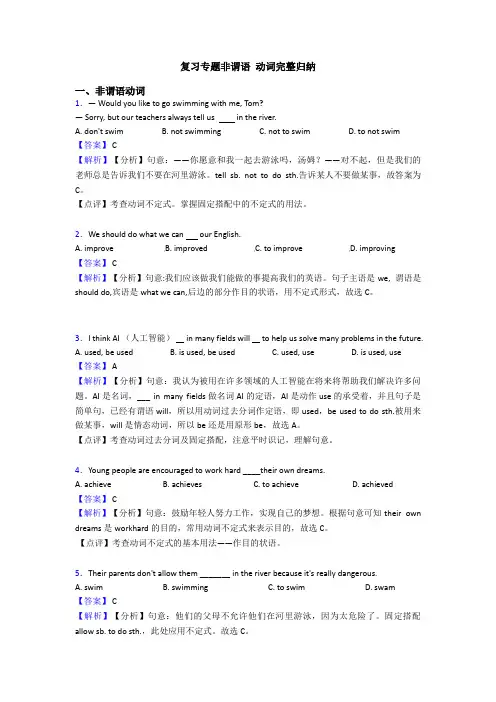
复习专题非谓语动词完整归纳一、非谓语动词1.— Would you like to go swimming with me, Tom?— Sorry, but our teachers always tell us in the river.A. don't swimB. not swimmingC. not to swimD. to not swim【答案】 C【解析】【分析】句意:——你愿意和我一起去游泳吗,汤姆?——对不起,但是我们的老师总是告诉我们不要在河里游泳。
tell sb. not to do sth.告诉某人不要做某事,故答案为C。
【点评】考查动词不定式。
掌握固定搭配中的不定式的用法。
2.We should do what we can our English.A. improveB. improvedC. to improveD. improving【答案】 C【解析】【分析】句意:我们应该做我们能做的事提高我们的英语。
句子主语是we, 谓语是should do,宾语是what we can,后边的部分作目的状语,用不定式形式,故选C。
3.I think AI (人工智能) in many fields will to help us solve many problems in the future.A. used, be usedB. is used, be usedC. used, useD. is used, use【答案】 A【解析】【分析】句意:我认为被用在许多领域的人工智能在将来将帮助我们解决许多问题。
AI是名词,___ in many fields做名词AI的定语,AI是动作use的承受着,并且句子是简单句,已经有谓语will,所以用动词过去分词作定语,即used,be used to do sth.被用来做某事,will是情态动词,所以be还是用原形be,故选A。
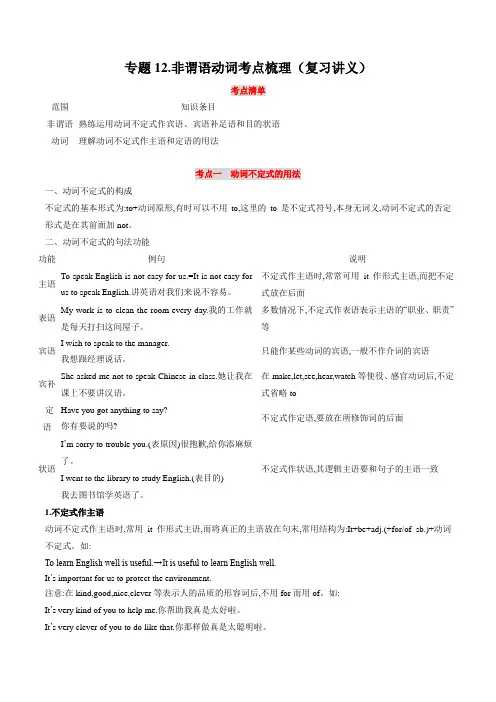
专题12.非谓语动词考点梳理(复习讲义)考点清单范围知识条目非谓语动词熟练运用动词不定式作宾语、宾语补足语和目的状语理解动词不定式作主语和定语的用法考点一动词不定式的用法一、动词不定式的构成不定式的基本形式为:to+动词原形,有时可以不用to,这里的to是不定式符号,本身无词义,动词不定式的否定形式是在其前面加not。
二、动词不定式的句法功能功能例句说明主语To speak English is not easy for us.=It is not easy forus to speak English.讲英语对我们来说不容易。
不定式作主语时,常常可用it作形式主语,而把不定式放在后面表语My work is to clean the room every day.我的工作就是每天打扫这间屋子。
多数情况下,不定式作表语表示主语的“职业、职责”等宾语I wish to speak to the manager.我想跟经理说话。
只能作某些动词的宾语,一般不作介词的宾语宾补She asked me not to speak Chinese in class.她让我在课上不要讲汉语。
在make,let,see,hear,watch等使役、感官动词后,不定式省略to定语Have you got anything to say?你有要说的吗?不定式作定语,要放在所修饰词的后面状语I’m sorry to trouble you.(表原因)很抱歉,给你添麻烦了。
I went to the library to study English.(表目的)我去图书馆学英语了。
不定式作状语,其逻辑主语要和句子的主语一致1.不定式作主语动词不定式作主语时,常用it作形式主语,而将真正的主语放在句末,常用结构为:It+be+adj.(+for/of sb.)+动词不定式。
如:To learn English well is useful.→It is useful to learn English well.It’s important for us to protect the environment.注意:在kind,good,nice,clever等表示人的品质的形容词后,不用for而用of。



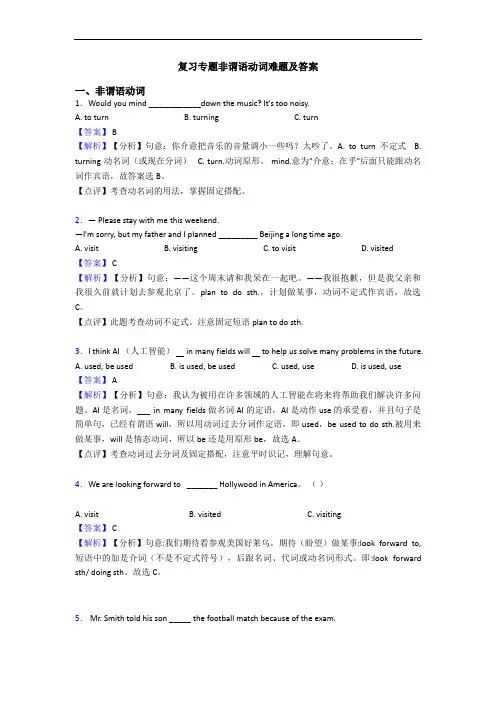
复习专题非谓语动词难题及答案一、非谓语动词1.Would you mind ____________down the music? It's too noisy.A. to turnB. turningC. turn【答案】 B【解析】【分析】句意:你介意把音乐的音量调小一些吗?太吵了。
A. to turn 不定式 B. turning 动名词(或现在分词) C. turn.动词原形。
mind.意为"介意;在乎"后面只能跟动名词作宾语,故答案选B。
【点评】考查动名词的用法,掌握固定搭配。
2.— Please stay with me this weekend.—I'm sorry, but my father and I planned _________ Beijing a long time ago.A. visitB. visitingC. to visitD. visited【答案】 C【解析】【分析】句意:——这个周末请和我呆在一起吧。
——我很抱歉,但是我父亲和我很久前就计划去参观北京了。
plan to do sth.,计划做某事,动词不定式作宾语,故选C。
【点评】此题考查动词不定式。
注意固定短语plan to do sth.3.I think AI (人工智能) in many fields will to help us solve many problems in the future.A. used, be usedB. is used, be usedC. used, useD. is used, use【答案】 A【解析】【分析】句意:我认为被用在许多领域的人工智能在将来将帮助我们解决许多问题。
AI是名词,___ in many fields做名词AI的定语,AI是动作use的承受着,并且句子是简单句,已经有谓语will,所以用动词过去分词作定语,即used,be used to do sth.被用来做某事,will是情态动词,所以be还是用原形be,故选A。
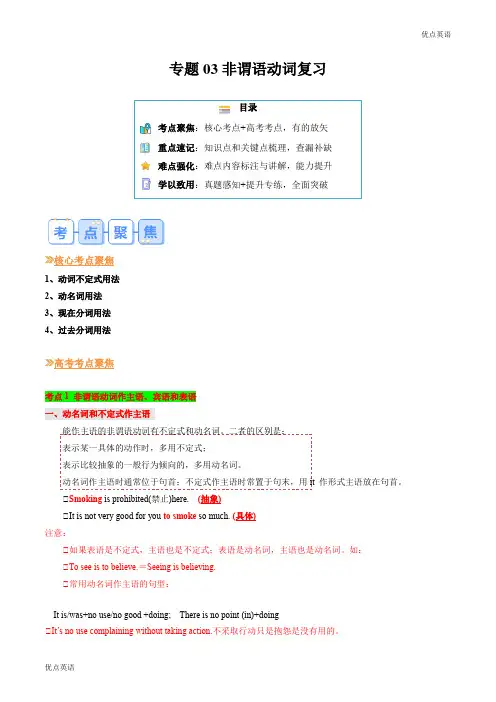
专题03非谓语动词复习目录考点聚焦:核心考点+高考考点,有的放矢重点速记:知识点和关键点梳理,查漏补缺难点强化:难点内容标注与讲解,能力提升学以致用:真题感知+提升专练,全面突破核心考点聚焦1、动词不定式用法2、动名词用法3、现在分词用法4、过去分词用法高考考点聚焦考点1 非谓语动词作主语、宾语和表语一、动名词和不定式作主语能作主语的非谓语动词有不定式和动名词。
二者的区别是:表示某一具体的动作时,多用不定式;表示比较抽象的一般行为倾向的,多用动名词。
动名词作主语时通常位于句首;不定式作主语时常置于句末,用it 作形式主语放在句首。
▶Smoking is prohibited(禁止)here. (抽象)▶It is not very good for you to smoke so much. (具体)注意:▶如果表语是不定式,主语也是不定式;表语是动名词,主语也是动名词。
如:▶To see is to believe.=Seeing is believing.▶常用动名词作主语的句型:It is/was+no use/no good +doing; There is no point (in)+doing▶It’s no use complaining without taking action.不采取行动只是抱怨是没有用的。
二、动名词和不定式作宾语1. 下列动词只能用不定式作宾语,请牢记下面的口诀决心学会想希望,拒绝设法愿假装。
主动答应选计划,同意请求帮一帮。
decide/determine,learn,want,expect/hope/wish; refuse,manage,care,pretend; offer,promise,choose,plan; agree,ask/beg,help。
此外,afford,strive,happen,wait,threaten等也要用不定式作宾语。
▶She pretended not to see me when I passed by.当我经过时,她假装没看见我。
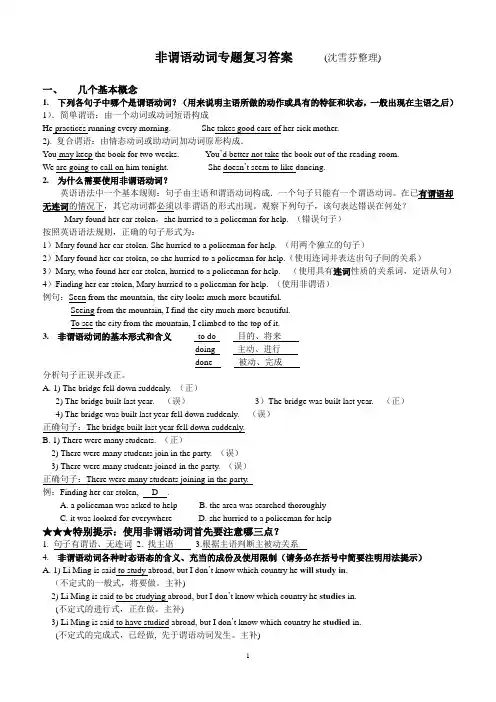
非谓语动词专题复习答案(沈雪芬整理)一、几个基本概念1.下列各句子中哪个是谓语动词?(用来说明主语所做的动作或具有的特征和状态,一般出现在主语之后)1).简单谓语:由一个动词或动词短语构成He practices running every morning. She takes good care of her sick mother.2). 复合谓语:由情态动词或助动词加动词原形构成.You may keep the book for two weeks. You’d better not take the book out of the reading-room.We are going to call on him tonight. She doesn’t seem to like dancing.2.为什么需要使用非谓语动词?英语语法中一个基本规则:句子由主语和谓语动词构成.一个句子只能有一个谓语动词。
在已有谓语却无连词的情况下,其它动词都必须以非谓语的形式出现。
观察下列句子,该句表达错误在何处?Mary found her car stolen,she hurried to a policeman for help. (错误句子)按照英语语法规则,正确的句子形式为:1)Mary found her car stolen. She hurried to a policeman for help. (用两个独立的句子)2)Mary found her car stolen, so she hurried to a policeman for help.(使用连词并表达出句子间的关系)3)Mary, who found her car stolen, hurried to a policeman for help. (使用具有连词性质的关系词,定语从句)4)Finding her car stolen, Mary hurried to a policeman for help. (使用非谓语)例句:Seen from the mountain, the city looks much more beautiful.Seeing from the mountain, I find the city much more beautiful.To see the city from the mountain, I climbed to the top of it.3.非谓语动词的基本形式和含义to do 目的、将来doing 主动、进行done 被动、完成分析句子正误并改正。

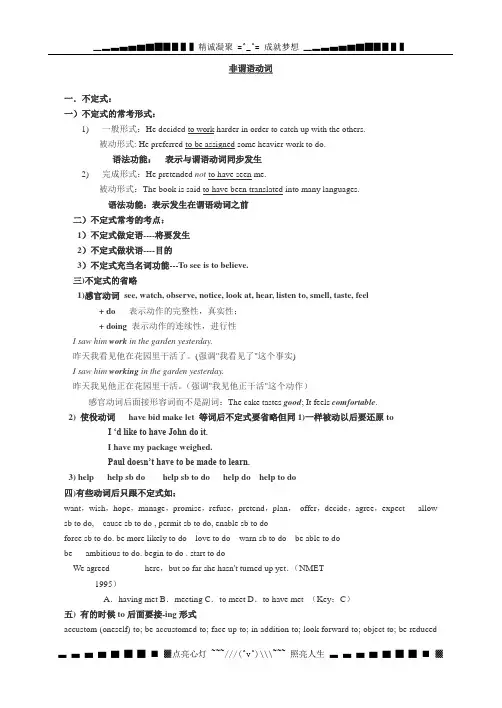
非谓语动词一.不定式:一)不定式的常考形式:1) 一般形式:He decided to work harder in order to catch up with the others.被动形式: He preferred to be assigned some heavier work to do.语法功能:表示与谓语动词同步发生2) 完成形式:He pretended not to have seen me.被动形式:The book is said to have been translated into many languages.语法功能:表示发生在谓语动词之前二)不定式常考的考点:1)不定式做定语----将要发生2)不定式做状语----目的3)不定式充当名词功能---To see is to believe.三)不定式的省略1)感官动词see, watch, observe, notice, look at, hear, listen to, smell, taste, feel+ do表示动作的完整性,真实性;+ doing表示动作的连续性,进行性I saw him work in the garden yesterday.昨天我看见他在花园里干活了。
(强调"我看见了"这个事实)I saw him working in the garden yesterday.昨天我见他正在花园里干活。
(强调"我见他正干活"这个动作)感官动词后面接形容词而不是副词:The cake tastes good; It feels comfortable.2) 使役动词have bid make let 等词后不定式要省略但同1)一样被动以后要还原toI ‘d like to have John do it.I have my package weighed.Paul doesn’t have to be made to learn.3) help help sb do help sb to do help do help to do四)有些动词后只跟不定式如:want,wish,hope,manage,promise,refuse,pretend,plan,offer,decide,agree,expect allow sb to do, cause sb to do , permit sb to do, enable sb to doforce sb to do. be more likely to do love to do warn sb to do be able to dobe ambitious to do. begin to do . start to doWe agreed _______ here,but so far she hasn't turned up yet.(NMET1995)A.having met B.meeting C.to meet D.to have met (Key:C)五) 有的时候to后面要接-ing形式accustom (oneself) to; be accustomed to; face up to; in addition to; look forward to; object to; be reducedto; resign oneself to; be resigned to; resort to; sink to; be used to; be alternative to; be close/closeness to; be dedication/dedicated to; be opposition/opposed to; be similarity/similar to.三、need/want 后的-ing形式具有被动的意思。
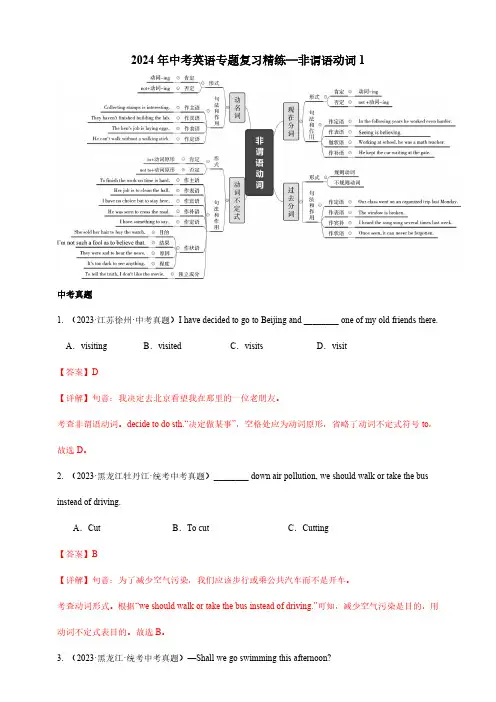
2024年中考英语专题复习精练—非谓语动词1中考真题1.(2023·江苏徐州·中考真题)I have decided to go to Beijing and________one of my old friends there. A.visiting B.visited C.visits D.visit【答案】D【详解】句意:我决定去北京看望我在那里的一位老朋友。
考查非谓语动词。
decide to do sth.“决定做某事”,空格处应为动词原形,省略了动词不定式符号to,故选D。
2.(2023·黑龙江牡丹江·统考中考真题)________down air pollution,we should walk or take the bus instead of driving.A.Cut B.To cut C.Cutting【答案】B【详解】句意:为了减少空气污染,我们应该步行或乘公共汽车而不是开车。
考查动词形式。
根据“we should walk or take the bus instead of driving.”可知,减少空气污染是目的,用动词不定式表目的。
故选B。
—I would rather________at home than________swimming.A.stay;going B.stay;go C.to stay;to go【答案】B【详解】句意:——今天下午我们去游泳好吗?——我宁愿待在家里也不愿意去游泳。
考查非谓语。
would rather do sth than do sth“宁愿做某事而不愿做某事”,即两空都用动词原形。
故选B。
4.(2023·江苏宿迁·统考中考真题)—Our school will invite Mr.Wang________us a talk on environmental protection next week.—That’s wonderful!A.give B.to give C.giving D.gave【答案】B【详解】句意:——下周我们学校将邀请王先生给我们做一个关于环境保护的演讲。
复习专题非谓语动词专项及解析一、非谓语动词1.—Amazing news! The Shape of Water won four Oscars this March!—I just can't wait it in the cinema.A. to watchB. watchC. watchingD. to watching【答案】 A【解析】【分析】句意:—好消息!今年三月,《水形物语》赢得了四项奥斯卡奖!—我只是迫不及待地想在电影院看这部电影。
根据“短语can't wait to do sth.:迫不及待地做某事”,故选A。
【点评】考查固定搭配wait to do。
2.The workers were made from morning to night in the past.A. workedB. to workC. workD. working【答案】 B【解析】【分析】句意:在过去工人们被迫从早晨工作到晚上make sb do sth让某人做某事,其被动语态形式sb be made to do sth所以选B。
3.I think AI (人工智能) in many fields will to help us solve many problems in the future.A. used, be usedB. is used, be usedC. used, useD. is used, use【答案】 A【解析】【分析】句意:我认为被用在许多领域的人工智能在将来将帮助我们解决许多问题。
AI是名词,___ in many fields做名词AI的定语,AI是动作use的承受着,并且句子是简单句,已经有谓语will,所以用动词过去分词作定语,即used,be used to do sth.被用来做某事,will是情态动词,所以be还是用原形be,故选A。
【点评】考查动词过去分词及固定搭配,注意平时识记,理解句意。
复习专题非谓语动词经典例题一、非谓语动词1.Attention, please! Without permission, children are not allowed alone here.A. to swimB. swimmingC. swimD. swam【答案】 A【解析】【分析】句意:请注意!未经允许,孩子们不能单独在这里游泳。
swim代词,游泳;to swim不定式形式;swam过去式。
固定搭配allow sb. to do sth.允许某人做某事,动词不定式作宾补;本句为此结构的被动形式be allowed to do sth被允许做某事。
故选A。
【点评】此题考查固定短语be allowed to do。
2.My parents didn't allow me ______ to the party.A. goB. to goC. goesD. went【答案】 B【解析】【分析】:本题考点为非谓语动词(固定用法)。
allow sb. to do sth.,即“允许某人做某事”。
故答案为B。
3.To live a low-carbon life, we must remember ________ the lights when we leave the room.A. to turn offB. turning offC. not to turn off【答案】 A【解析】【分析】句意:要过低碳生活,我们必须记住离开房间时要关掉灯。
remember (not)to do sth.忘记要做的事;remember doing sth.忘记已经做过的事。
根据句末when we leave the room.可知关灯的动作还没有做,此处表示肯定含义,要用不定式的肯定式,故选A。
【点评】考查动词remember的固定搭配。
根据所表示的含义选择正确的搭配。
4.Jane was shy. She would not invite her classmates____speaking English.A. practiceB. practicesC. practicingD. to practice【答案】 D【解析】【分析】句意:詹妮胆小害羞,她不会邀请她的同学练习讲英语。
复习专题非谓语动词知识点(大全)一、非谓语动词1.Nowadays,most people prefer to________ computer games rather than ___________ books.A. play;readingB. play;readC. playing; reading【答案】 B【解析】【分析】句意:现在,大部分人比起读书更喜欢玩电脑游戏。
prefer to doA rather than do B比起B更喜欢做A。
故答案为B。
【点评】考查动词prefer的用法,掌握固定搭配。
2.When you leave, please turn off the lights energy.A. saveB. to saveC. savingD. saved【答案】 B【解析】【分析】句意:当你离开时请关灯以节约能源。
动词不定式表示目的,结合句意,故选B。
3.一What should we take when going birdwatching? 一 We should take a pair of binoculars____________the birds clearly.A. seeB. seeingC. to seeD. sees【答案】C【解析】【分析】句意:一去看鸟应该带什么?一为了看得清楚,我们应该带一副望远镜。
带上望远镜的目的是看得清楚,用带to的不定式作目的状语。
故选C。
4. Though he often made his little sister ______, today he was made ______ by his little sister.A. cry; to cryB. crying; cryingC. cry; cryD. to cry; cry【答案】 A【解析】【分析】句意:虽然他经常使他的妹妹哭,但是今天他妹妹使他哭了。
2024年中考英语专题复习精练—非谓语动词2练习词汇运用1.(2023·甘肃天水·统考中考真题)You’re expected ______ (shake) hands when meeting people for the first time in China.【答案】to shake【详解】句意:当你第一次在中国与人见面时,你应该握手。
be expected to do sth“被期望做某事”,shake hands“握手”。
故填to shake。
2.(2023·甘肃天水·统考中考真题)Let me __________ (tell) you about my favorite book.【答案】tell【详解】句意:让我告诉你我最喜欢的书。
tell“告诉”,let sb. do sth.“让某人做某事”。
故填tell。
3.(2023·湖南永州·统考中考真题)I’ve decided _________(stay)away from fried food and soft drinks since I had my medical exam.【答案】to stay【详解】句意:自从体检后,我决定远离油炸食品和软饮料。
decide to do sth“决定做某事”,为固定短语,故填to stay。
4.(2023·江苏无锡·统考中考真题)The firemen had no choice but (break) the window.【答案】to break【详解】句意:消防队员别无选择,只能打碎窗户。
break“打破”,动词。
have no choice but to do sth.“除了做某事别无选择”,故用动词不定式。
故填to break。
5.(2023·江苏无锡·统考中考真题)What you (do) to my computer? It’s dead!【答案】have done【详解】句意:你对我的电脑做了什么?它死机了!分析句子可知,电脑现在死机了,过去对电脑做的事情,对现在产生了影响,应为现在完成时,结构是has/have done,主语是第二人称you,助动词6.(2023·江苏无锡·统考中考真题)Go and have a good sleep, baby. Let me (worry) about these things.【答案】not worry【详解】句意:去睡个好觉吧,宝贝。